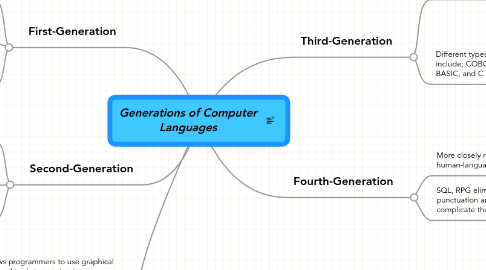Generations of Computer Languages
por Jason Koterba


1. Second-Generation
1.1. Assembly Languages
1.2. Allowed programmers to use abbreviated command words (LDA = Load)
1.3. Typically used to write system software
2. Fifth-Generation
2.1. Allows programmers to use graphical or visual tools to construct programs
2.2. Uses Prolog
2.2.1. Prolog - a computer programming language based on a declarative programming paradigm.
3. First-Generation
3.1. Machine Languages
3.2. Consists of a set of commands, represented by 1s and 0s
3.3. Programmers rarely use Machine Languages to write programs
4. Third-Generation
4.1. Uses easy-to-remember command words (PRINT and INPUT)
4.2. Different types of languages include; COBOL, Fortran, Pascal, BASIC, and C
4.2.1. COBOL and Fortran - useful for business and scientific applications.
4.2.2. Pascal and BASIC - Teaching teacniques
4.2.3. C - useful for system and application software development
